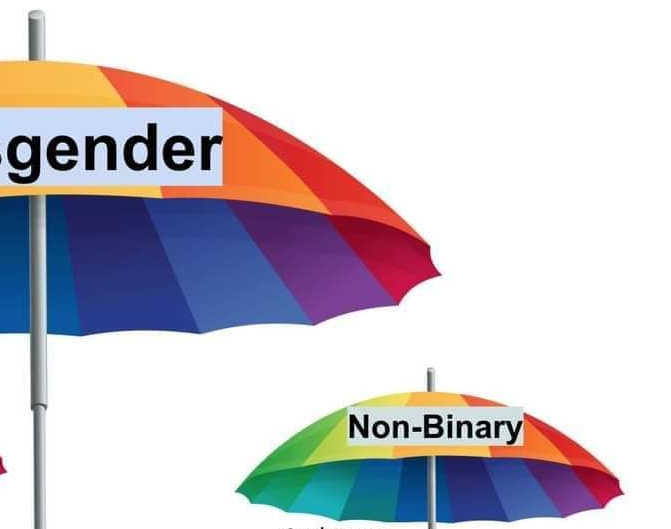What do we mean when we say there are infinitely many genders?
In math, we have multiple kinds of infinities. The most intuitive one for most people is “countable infinity”. That’s the kind of infinite that the counting numbers are – if you start counting 0, 1, 2, 3, …, you’ll never get to the biggest number, because no matter how high of an n you count up to, you can always count higher by adding to get n+1.
This set of counting numbers that starts with 0, 1, 2, 3… is called the natural numbers (often written as N). We say a set A is countably infinite if every element of A can be mapped onto exactly one element of N. So if the genders were countable, we could create an encoding of “gender #1”, “gender #2”, etc., that would include all of them.
The limits of the acronym approach
Most of us are familiar with the acronym LGBT, and the fact that there are variations on it: LGBTQ, LGBTQIA, LGBTTIQQ2SA, etc. Acronyms have a first character, a second character, and so on – no matter how long we make them, they remain countable. Adding “+” at the end captures the infinite nature of any acronym, but using an acronym at all still implies that the overall kind of infinity we’re dealing with, is countable.
For the sake of argument, let’s imagine that there is a perfect acronym sn, a series of characters that ends with “+”, where the “+” represents a well-defined rule for generating all the genders that aren’t already listed in the first part of the acronym. We could imagine representing all potential combinations of identities as a string of bits (1 or 0) indicating, for each letter of that perfect acronym, whether or not that letter applies to a specific person. So if the acronym starts with LGBT…, and I am a non-trans lesbian, then my One True gender encoding would start with 1100.
The mathematician Georg Cantor’s diagonal proof that some sets are uncountable is applicable here. If we started writing out all those encodings of identities within the acronym, we would get a table like the first box in this diagram:
The second box shows a general technique for finding gender that are still left out, even if the first box is fully expanded and has an infinite number of rows! If you take the first bit of the first identity and invert it, then the second bit of the second identity and invert it, and continue down the list, you will have a new identity that isn’t listed anywhere in the first box. This means the first box was incomplete, and therefore that the set of all possible identities is not countable.
Quantized Spectra: Possibilities and Perils
By “quantized spectra” I mean things like the genderbread person, that attempt to break gender/sexuality down into a collection of one-dimensional, non-intersecting lines, where people are encouraged to place themselves as a point on each line.

Every iteration of this concept is met with a bunch of critiques, and these critiques are usually met with refinements that add more categories but keep the same underlying concept. While I recognize that these sorts of breakdowns have been helpful for a lot of young people as a way to map complexities of their identities that are not captured by fully discrete formulations like acronyms, I think it’s important to identify the theoretical limits of this approach instead of just proliferating new versions.
The quantized spectra approach allows for an uncountable number of genders, since the point on each individual spectrum can correspond to any real number (including irrational ones like pi or the square root of two), and not just counting numbers. This comes at a cost though: we lose all the unquantifiable combinations, interactions, and contradictions. The specificity of an identity like “butch lesbian” is impossible to fully capture in a chart like this, because the masculinity is not separable from the femaleness, the gayness is not separable from the gender of the people involved, etc. etc.

A non-solution: umbrella identities
One recurring pattern in gender discourse is to introduce umbrella terms. For example, “Queer” has in many circles been reclaimed as an umbrella term designed to encompass all of LGBT and then some. So there are people who say we should just say “Queer” instead of trying to enumerate identities in an acronym at all. But there are also L, G, B, and/or T people who, for various reasons, do not want to be called Queer and feel excluded when “Queer” is used as an umbrella. So we compromise by adding a Q to the acronym, LGBTQ. Now we’re back to an acronym, with the same problems as before.
I recently discovered that I am cited on the nonbinary.wiki page on “metagender”. This is very exciting in some ways – I want to contribute to The Discourse, and this is a sign that I’m succeeding. On the other hand, I’m a little ambivalent because I do not identify as metagender and in fact don’t particularly like that term. It’s the same pattern as LGBT/Q:
- Different groups with something material in common create an umbrella term to name their commonalities (e.g., “transgender”)
- Some people like the umbrella term so much that they start to use it as a standalone identity
- The new identity takes on a life of its own: a community emerges around it, essentializing definitions are put forth, and it comes to mean both more and less than the material conditions it was originally created to merely describe.
- The same things that happen in any community happen: There are conflicts, dramas, schisms, cooptations, and other new developments. Eventually, you have people whose material conditions are consistent with inclusion in the original denotative definition, but who are not part of The Community, don’t want to be associated with it, and actively dis-identify from the new term.
- Some well-meaning radicals who want to unify the people on various sides of these schisms introduce a new umbrella term (e.g., “metagender”), and we’re back to step 1.
Uncountable non-umbrellas
As the quantized spectra phenomenon illustrates, there is more than one cardinality of uncountable set. It’s a whole branch of math. “Countable” tells you what a set is, “uncountable” only tells you something about what it is not.
The most enduring umbrella terms seem to follow this pattern. Non-straight. Non-cis. Non-binary. Non-white. Non-normative. In other areas too, this is by far the most palatable form of binary: A COVID-19 test tells you only if what you have is COVID or Non-COVID, but we don’t tend to see broad philosophical critiques of the lumping together of all other ailments under the label “non-COVID”, because that was never the point.
This sort of binary is always already incomplete, it leaves room to “develop action, thought, and desires by proliferation, juxtaposition, and disjunction, and not by subdivision and pyramidal hierarchization.” (Foucault’s summary of Deleuze and Guattari’s Anti-Oedipus). To make this concrete: For any pair of labels like male/female, gay/straight, or cis/trans, we must consider the possibility that it’s not just either/or (subdivision), but that there is also a way to be both (juxtaposition) and a way to be neither (disjunction). Then we must imagine that there is more than one way to be both or neither (proliferation) — and we must resist the temptation to taxonomize these possibilities by placing them underneath any hierarchizing umbrellas.

Neither… nor… nor… can be generative if we let it. If we ever discovered the One True gender taxonomy, there would immediately be people identifying outside of it. That’s a good thing, that’s just proof we have agency. Genders are being created, we’re not just uncovering something that’s already there. Let’s embrace it.


